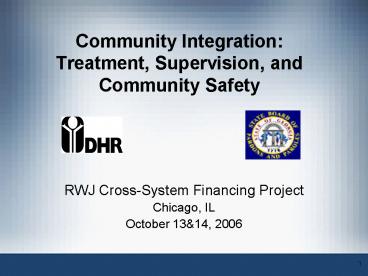Community Integration: Treatment, Supervision, and Community Safety - PowerPoint PPT Presentation
1 / 22
Title:
Community Integration: Treatment, Supervision, and Community Safety
Description:
Community Support Individual. Physician Assessment. Nursing Assessment. Individual Counseling ... Governor's Commission for a New Georgia: ... Few new state dollars ... – PowerPoint PPT presentation
Number of Views:52
Avg rating:3.0/5.0
Title: Community Integration: Treatment, Supervision, and Community Safety
1
Community IntegrationTreatment, Supervision,
and Community Safety
- RWJ Cross-System Financing Project
- Chicago, IL
- October 1314, 2006
2
Georgias State Team
- Marta Daniell, Program Manager, State Board of
Pardons and Parole (SBPP) - Wendy Tiegreen, Director of Provider Network
Development, Division of Mental Health,
Developmental Disabilities, and Addictive
Diseases (MHDDAD), DHR - Neil Kaltenecker, Director, Office of Addictive
Diseases, MHDDAD, DHR
3
Context
- Georgias Adult Offender Population
- FY 2005
- 24,276 State Parolees
- 50, 921 State Inmates
- 133,165 State Probationers
- 5,080 Probation Facilities
- 6,079 County-Sentenced
- 262,041 MM Probationers
- 21,630 In Jail Awaiting Trial
4
Context
- 1,478 paroled or reprieved with a Special
Condition for MH counseling - 6,656 parolees newly enrolled in ASAM Level 1
substance abuse treatment (2,933, or 44,
completed) - 81,972 random drug screens for parolees (15
positive)
5
Context
- Approximately 75 of offenders enter prison
with a drug-related history - Less than 1 of prison beds are designated for
residential substance abuse treatment (RSAT)
6
The State Benefit Package-Services
- Core Services
- Diagnostic Assessment
- Community Support Individual
- Physician Assessment
- Nursing Assessment
- Individual Counseling
- Family Counseling/Training
- Group Counseling/Training
- Medication Administration
- Crisis Intervention
7
The State Benefit Package-Services
- Specialty SA Services
- Crisis Stabilization Program
- Ambulatory Detox
- SA Residential
- SA Day Treatment
- Consumer/Family Supports
8
Context
- Governors Commission for a New Georgia
- Develop an effective intervention program for the
MH/AD needs of the adult offender population - Lack of effective treatment leads to high
recidivism rates (as high as 40) for discharged
offenders
9
Context
- Recent history of addiction services not being
available for parolees upon release - Grant-in-Aid Funding for Adult MH/SA
- Housing Needs vs. Residential Treatment
10
Goal
Treatment contracted through MHDDAD Treatment contracted through SBPP
Single System for Community Integration for CJ
Populations
11
- Grant-in-Aid funding process through FY07
- Few new state dollars
- Priority services for those being released from
institutions and those in CJ system. - Defining targeted treatment levels (ASAM 2.1 and
above) - Statewide Crisis and Access Line (July 1, 2006)
12
- ASAM Level 1 statewide, including assessment
- 60-bed SA residential treatment for parolees (5
month length of stay) - Parole Reporting Center w/ emphasis on SA
treatment in largest county in Georgia
(Metro-Atlanta) - Drug testing
- Refer to OAD community providers for
higher-levels of SA treatment
13
Cross System Support and Contribution
OAD
OAD/SBPP
SBPP
ASAM Level 2.1 and above Training Co-occurring MH/AD treatment Assessment ASAM Level 1 Recovery Supports (DOL, DTAE, Cog. Skills training)
14
Accomplishments so far
- Series of meetings with staff from Pardons and
Parole and Office of Addictive Diseases - Data of releases w/ Special Condition of SA
treatment, revoked with a positive drug test - Number of consumers being served in Core and
Specialty services - Input from community SA provider
- Input/feedback from SBPP field staff
15
NIDA - Principles of Drug Abuse Treatment for
CJ Populations
- Drug addiction is a brain disease that
affects behavior. - Recovery from drug addiction requires effective
treatment, followed by management of the problem
over time. - Treatment must last long enough to produce stable
behavioral changes. - Assessment is the first step in treatment.
- Tailoring services to fit the needs of the
individual is an important part of effective drug
abuse treatment for criminal justice populations.
16
NIDA - Principles of Drug Abuse Treatment for
CJ Populations
- Drug use during treatment should be carefully
monitored. - Treatment should target factors that are
associated with criminal behavior. - Criminal justice supervision should incorporate
treatment planning for drug abusing offenders,
and treatment providers should be aware of
correctional supervision requirements. - Continuity of care is essential for drug abusers
re-entering the community. - A balance of rewards and sanctions encourages
pro-social behavior and treatment participation.
17
NIDA - Principles of Drug Abuse Treatment for
CJ Populations
- Offenders with co-occurring drug abuse and mental
health problems often require an integrated
treatment approach. - Medications are an important part of treatment
for many drug abusing offenders. - Treatment planning for drug abusing offenders who
are living in or re-entering the community should
include strategies to prevent and treat serious,
chronic medical conditions, such as HIV/AIDS,
hepatitis B and C, and tuberculosis.
18
Demonstration Project
19
Things to do
- Identify potential funding
- Select pilot sites based on
- Urban, suburban, and rural locations
- Quality of provider agencies
- Supportive field staff
- Develop Timeline for implementation
20
Considerations
- Major Shift in OAD Purchasing Practices
- Developing an MH/SA Adult Services Purchasing
Plan - Parole Board Support
21
Implementation
- Project Manager
- RFQC
- Training
- Evaluation Plan
- On-going Adjustments
22
Ultimate Success
- Positive Outcomes
- Integrated delivery system for Parolees
- Transfer to Adult Probation and Juvenile
Correctional Systems - Approach Legislature w/ budget request based on
need































